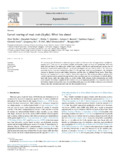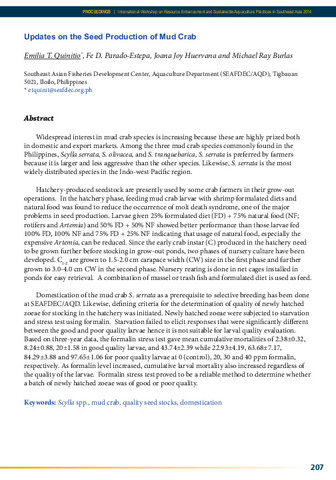| dc.contributor.author | Huervana, Joana Joy D. C. | |
| dc.contributor.author | Corre, Valeriano L. Jr. | |
| dc.contributor.author | Quinitio, Emilia T. | |
| dc.contributor.editor | Quinitio, Emilia T. | |
| dc.contributor.editor | Parado-Estepa, Fe Dolores | |
| dc.contributor.editor | Coloso, Relicardo M. | |
| dc.date.accessioned | 2017-08-25T08:59:50Z | |
| dc.date.accessioned | 2017-08-25T16:31:23Z | |
| dc.date.available | 2017-08-25T08:59:50Z | |
| dc.date.available | 2017-08-25T16:31:23Z | |
| dc.date.issued | 2017 | |
| dc.identifier.citation | Huervana, J. J. D. C., Corre, V. L. Jr., & Quinitio, E. T. (2017). Induction of molting in hatchery-reared mud crab Scylla serrata juveniles through temperature manipulation or autotomy. In E. T. Quinitio, F. D. Parado-Estepa, & R. M. Coloso (Eds.), Philippines : In the forefront of the mud crab industry development : proceedings of the 1st National Mud Crab Congress, 16-18 November 2015, Iloilo City, Philippines (p. 145). Tigbauan, Iloilo, Philippines: Aquaculture Department, Southeast Asian Fisheries Development Center. | en |
| dc.identifier.isbn | 9789719931072 | |
| dc.identifier.uri | http://hdl.handle.net/10862/3179 | |
| dc.description | Abstract only. | en |
| dc.description.abstract | The effects of water temperature and autotomy of chelipeds on growth, survival and molting of mud crab, Scylla serrata, juveniles were investigated under laboratory conditions in separate experiments. Hatchery-produced crabs at the intermolt stage with 2.0-2.3 cm carapace width and 1.7-2.2 g body weight were either exposed to temperature levels of 29, 32 and 35°C and ambient temperature of 24-31°C or subjected to autotomy (voluntary removal of one or two chelipeds). The crabs were allowed to molt twice prior to termination.
All crabs held at 35°C had 100% mortality due to incomplete molting during the first molt. The mean survival of crabs upon termination was 58, 64 and 50% for ambient temperature, 29 and 32°C, respectively. Specific growth rate (SGR) of crabs in the ambient (2.83 ± 0.12%) and 29°C (3.02 ± 0.15%) were comparable but significantly lower than (P<0.01) those at 32°C (3.85 ± 0.28%). The molt interval of crabs was significantly shorter in treatments with constant water temperature (29°C: 32 ± 0.80 days, 32°C: 28 ± 1.11 days) compared to ambient temperature (39 ± 0.93 days).
The survival of crabs with intact chelipeds (51.17 ± 3.56%) was comparable to those with one (50.55 ± 2.36%) or two (43.41 ± 1.59%) autotomized chelipeds. Juveniles with intact (5.80 ± 0.47%) or one autotomized cheliped (5.45 ± 0.30%) had a significantly higher SGR than crabs with both chelipeds autotomized (4.20 ± 0.52%) in the first molt. On the second molt, however, high SGR was observed in crabs with two chelipeds autotomized. The molt interval was significantly shorter in the autotomized crabs (one cheliped: 28 ± 1.66 days; two chelipeds: 23 ± 0.63 days) compared to those with intact chelipeds (36 ± 1.52 days). The results suggest that optimum water temperature for rearing S. serrata juveniles ranges from 29 to 32°C. Likewise, autotomy of one cheliped can promote molting without adversely affecting the growth and survival of the juveniles. | en |
| dc.language.iso | en | en |
| dc.publisher | Aquaculture Department, Southeast Asian Fisheries Development Center | en |
| dc.subject | Scylla serrata | en |
| dc.subject | Philippines | en |
| dc.title | Induction of molting in hatchery-reared mud crab Scylla serrata juveniles through temperature manipulation or autotomy | en |
| dc.type | Conference paper | en |
| dc.citation.spage | 145 | |
| dc.subject.asfa | autotomy | en |
| dc.subject.asfa | stress | en |
| dc.subject.asfa | crab culture | en |
| dc.subject.asfa | crustacean larvae | en |
| dc.subject.asfa | larval stage | en |
| dc.subject.asfa | marine crustaceans | en |
| dc.subject.asfa | mortality | en |
| dc.subject.asfa | moulting | en |
| dc.subject.asfa | survival | en |
| dc.subject.asfa | temperature effects | en |
| dc.citation.conferenceTitle | Philippines : In the forefront of the mud crab industry development : proceedings of the 1st National Mud Crab Congress, 16-18 November 2015, Iloilo City, Philippines | en |
| dc.subject.scientificName | Scylla serrata | en |



